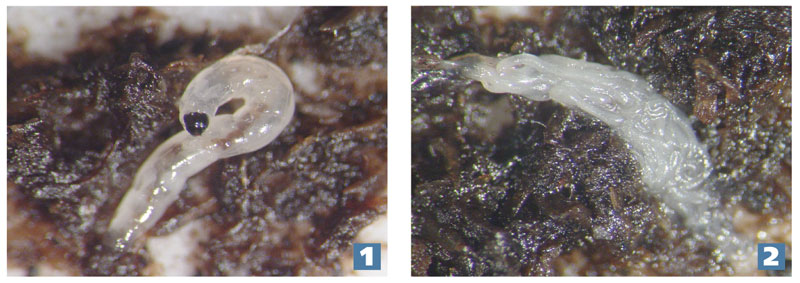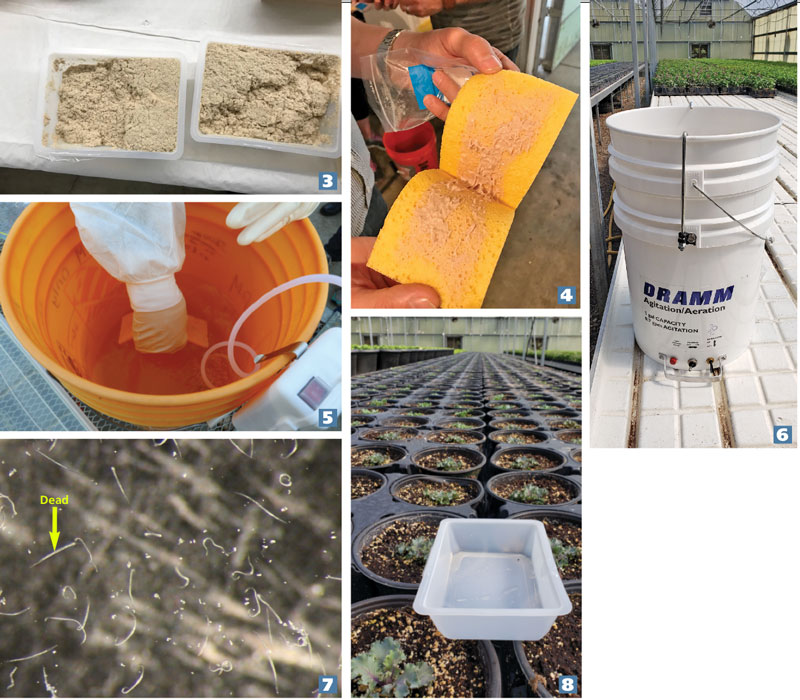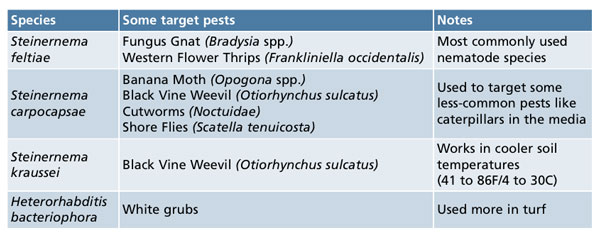5/1/2021
Best Practices for Biocontrols, Part 4
John Sanderson, Suzanne Wainwright-Evans & Ronald Valentin

Figures 1 and 2. Healthy fungus gnat larva (left) and after infection by insect-killing nematodes (right). Photos by John Sanderson.
Growers who are interested in using biological controls are encouraged to begin by using beneficial nematodes to manage fungus gnat larvae and Western flower thrips pupae. Beneficial nematodes are relatively easy to use and are applied similarly to conventional pesticides with some special precautions listed in this article.
What are beneficial nematodes?
Nematodes are small, colorless, cylindrical round worms that occur naturally and abundantly in soils throughout the world. Certain nematode species attack and kill insects, and are called entomopathogenic nematodes (EPNs). EPNs are usually used against soil-dwelling pests. Different species work best against different pests. For greenhouse crops, Steinernema feltiae is used against fungus gnat larvae and pupae of Western flower thrips and onion thrips in the soil. Steinernema feltiae doesn’t control shore flies. However, Steinernema carpocapsae is sold to suppress shore fly larvae. EPNs only target the life stage of the insects in the soil, so don’t offer control for the adult life stage.
EPNs enter the insect host through body openings. They release a symbiotic bacterium whose toxin kills the pest insect. The pest is killed in one to two days by blood poisoning and its body disintegrates (Figures 1 and 2).
EPNs come in different formulations and packaging (Figures 3 and 4). Some are mixed into hydrogels and others into powder. Smaller amounts are often sold on sponges, while larger quantities come in trays or bags. There is a new formulation that will be hitting the market this fall from BioBee, a slow-release capsule that will be pre-incorporated into media so growers won’t have to apply as often.
Figure 3. Nematodes mixed into hydrogel in trays. Covers have been removed from these trays so they’re ready to be mixed into a spray solution. Photo by John Sanderson.
Figure 4. Some nematode products are sold on moist sponges to be mixed into a spray solution. Photo by John Sanderson.
Figure 5. Mixing nematodes on a sponge into a spray bucket. Note the aeration/agitation unit, which is important to keep the nematodes aerated and suspended in the solution. Photo by Suzanne Wainwright-Evans.
Figure 6. Aeration/agitation bucket sold by Dramm Corporation, which provides excellent aeration and agitation for nematode applications. Photo by Suzanne Wainwright-Evans.
Figure 7. Nematodes should be checked for viability before mixing into a spray tank or to ensure their viability after traveling through the application equipment. Healthy nematodes will have at least a slight “J” curl, whereas dead ones will be straight and still. Photo by John Sanderson.
Figure 8. To check nematode viability after an application, use a tray to capture some spray solution during the application and then examine the nematodes in the captured solution. Photo by Suzanne Wainwright-Evans.

How to use beneficial nematodes
Preventative applications to moist soils work best, but can be used as a curative for moderate fungus gnat infestations. Apply EPNs with a sprayer (remove screens and filters), injector, hose end sprayer or even a watering can. If using an injector, set the dilution to 1:100. Remove all filters or screens (50 mesh or finer) in any spray lines so the EPNs can pass through unimpeded and undamaged, and spray pressure should be kept below 300 psi.
Although EPNs are applied in water, they’re not aquatic animals and therefore need extra care while in stock and tank solutions, so adequate aeration of the EPN suspension during application is important. This can be done using a small battery-powered submersible pump or even mechanically. The small pump will also keep the EPNs from settling on the bottom, which they readily will do if the solution isn’t constantly agitated. It’s very important to keep the spray solution agitated so the EPNs will remain suspended in the solution (Figure 5). Dramm Corporation sells specialized equipment for EPN applications called an aeration/agitation bucket (Figure 6) or a 50-gal. cart.
Unlike many traditional pesticides, there’s no REI, so no loss of work time, and little likelihood that the target pest will develop resistance. They’re safe to use around employees and greenhouse cats, but EPNs are living organisms, so there are a number of precautions you need to follow for their successful use.
Research on temperature effects on nematodes from Cornell University by Anna Giesmann and John Sanderson has shown that temperature can be very important for optimal EPN performance. The EPNs S. feltiae and S. carpocapsae work well at cool temperatures, such as 55F (12C) or cooler. Mixing them into cool tap water in winter shouldn’t be harmful unless water temperature is unusually cold.
Hot temperatures can be more of a problem. Steinernema feltiae cannot tolerate a temperature of 95F (35C) for longer than four hours in either the spray tank or growing mix. Steinernema carpocapsae can survive temperatures up to 113F (45C), but only for one hour. At these higher temperatures, S. carpocapsae should perform better than S. feltiae, so the suspension in the spray tank should be kept cool and applied as soon as possible after mixing.
In warm weather, some growers may use an ice pack to keep the water cooler. This is especially important during the warmer months. The longer the EPNs are kept before spraying and the warmer the tank water, the more quickly their energy reserves are used up. Weaker EPNs are less robust during and after application, and less able to search for and infect a susceptible host. Even under favorable temperature conditions, the EPNs should be applied soon after mixing into the tank. If the EPNs have been stored in a refrigerator, allow them to warm to room temperature before mixing with warmer water to avoid heat shock. Hoses that have been laying in sunlight could contain very hot water, so run water through the hose until cooler water flows.
Check their viability before and/or after application. EPNs can easily be checked for viability after storage before mixing into a spray tank or to ensure their viability after traveling through the application equipment. To check viability after refrigerator storage, let the product come to room temperature, then place a tiny amount of the product in a small clear container or petri dish. Add one or two drops of room temperature water, wait a few minutes and look for actively moving or swimming EPNs with a hand lens or microscope. Living EPNs will be curled or have at least a slight “J” curvature. Dead EPNs will be very straight and still (Figure 7). Use a dark black background to see the EPNs.
To check whether they survived an application, capture some of the spray mixture into a container (Figure 8) and carefully filter the water through a coffee filter to capture and concentrate the EPNs into a spot on the filter. Cut out this spot, rinse it with water into a small clear container over a dark background and check them with a hand lens or microscope.
Compatibility EPNs are compatible with a number of pesticides. However, they’re generally not compatible with organophosphates, carbamates, nematicides and hydrogen dioxide. Do not mix EPNs with your fertilizer solution! For more detailed information on pesticide compatibility, consult with your supplier or BASF. BASF has done extensive testing on EPN and pesticide compatibility.
Getting the most out of your nematodes
• Begin S. feltiae applications as soon as possible (two to three days) after sticking cuttings, planting plugs or starting seeds. Some growers apply EPNs to the media directly before sticking cuttings to ensure that the EPNs reach the media. Injectors are placed directly on the planting line.
• Irrigate the growing media before application (EPNs need moisture for movement), but avoid overwatering. If you’re using a peat-based medium, you may want to add a wetting agent so the EPNs get down into the media. After application, do not overwater to avoid washing the EPNs out of containers.
• Media temperatures should be above 50F (10C), but avoid applying S. feltiae when soil temperatures are above 90F (32C). Optimum media temperatures are between 60 to 75F (15 to 23C). Use a soil thermometer to monitor temperatures.
• Apply in the evening or at dawn or on a cloudy, overcast day. (EPNs are very sensitive to UV light and desiccation.)
• Re-application can depend on pest species, rates used, pest pressure and other factors. Best to talk with your supplier about a program.
• EPNs do not work on all thrips species. This is why identification is so important. Species like the poinsettia thrips (Echinothrips americanus) doesn’t pupate in the soil, but on the leaves. Chilli thrips (Scirtothrips dorsalis) are so small that the EPNs cannot easily get into their tiny bodies.
• Use sticky traps to monitor pest levels while using EPNs, recognizing that there will be a lag time between EPN application against the larvae/pupae and adult catches on sticky traps.
• For Western flower thrips, normally EPNs aren’t used as a standalone, but in a program that utilizes releases of predatory mites such as Neoseiulus cucumeris or Amblyseius swirskii. Combing EPNs with predatory mites will target the young thrips on the foliage with the mites and the thrips pupating in the soil with the EPNs.
 Storing nematodes
Storing nematodes
Apply immediately after receiving them, if possible. If you must store the EPNs, store them in a refrigerator (38 to 42F/3 to 5C). Avoid placing them in a small refrigerator where they may freeze and die. Check the expiration date on the package for the length of time they can be stored or ask your supplier. Different formulations of EPNs can have very different shelf lives. Do not use an EPN package that’s been previously opened unless it’s been opened only very briefly and stored in an airtight plastic bag.
Growers have used EPNs successfully for decades as part of their biocontrol program. We’ve come a long way with their use and still have more to learn. We hope the information in this article leads to your success. GT
John Sanderson is an Associate Professor at Cornell University in Ithaca, New York, and has worked on research and extension for greenhouse pest management for over 30 years. Suzanne Wainwright-Evans is the owner of Buglady Consulting, now in business 20 years. She specializes in biological control agents and trouble-shooting pest issues in ornamentals, cannabis and other specialty crops. Ronald Valentin is Technical Director BCA for BioWorks, Inc. and has been active in Biological Control for over 30 years in Europe, Canada and the U.S.